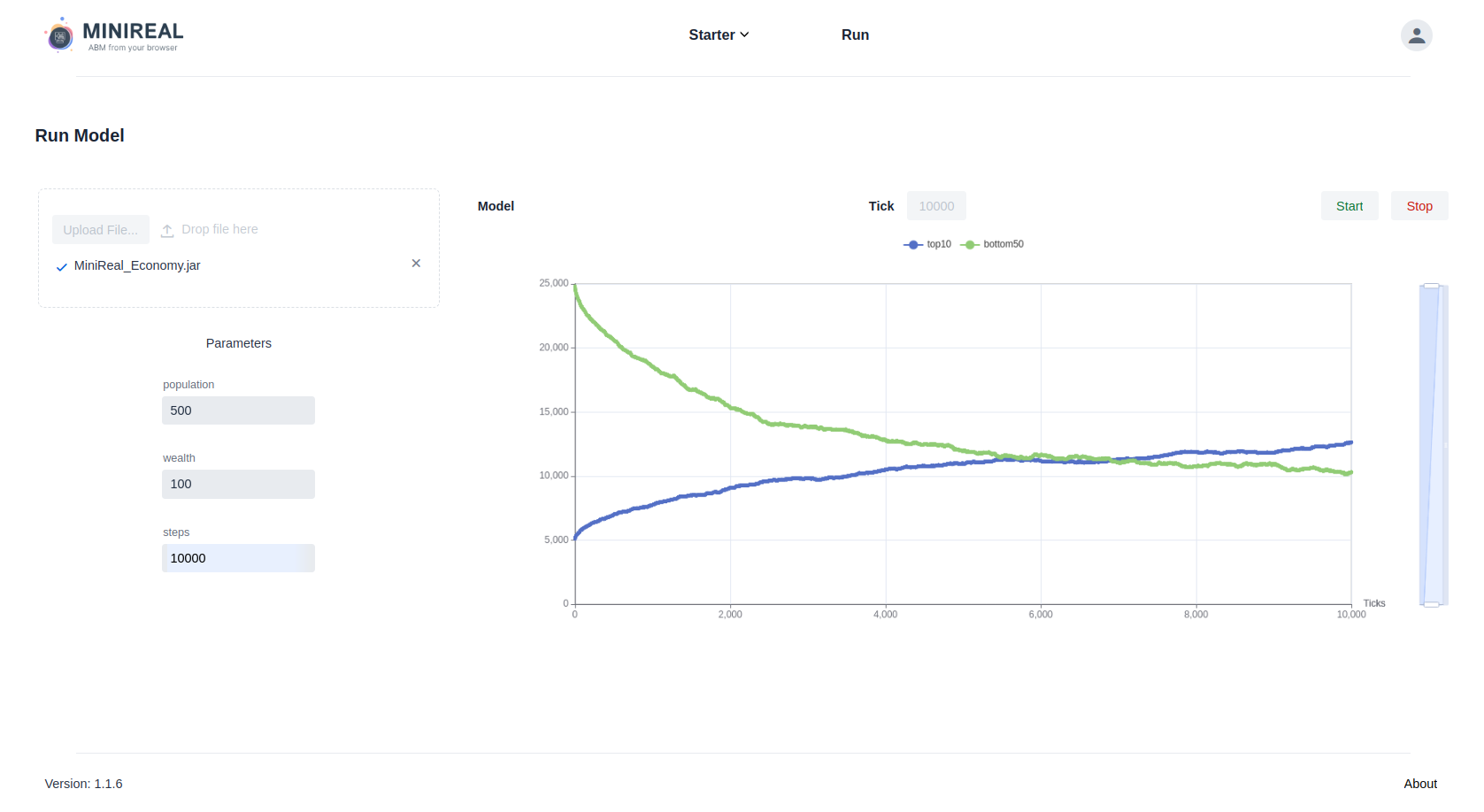Economy Sample Model
The Simple Economy model represents an ecosystem with a fixed amount of money distributed equally among all agents (representing individuals). In each tick of the simulation, an agent gives one unit of money to a randomly selected agent.
The experiment explores how wealth distribution evolves over time, providing an abstract framework to study the factors that influence wealth distribution in society.
The source code for the Simple Economy model can be obtained from a deployed MiniReal system or from the Sample Models repository.
Model
When designing a use case in Agent-Based Modeling (ABM), several key aspects must be
considered: model parameters, agent space, and output observation. In the Simple Economy model,
parameters include the agent population size and initial wealth, and varying these provide
insights into system behavior.
The model’s space or field structure defines agent interaction. For the Simple Economy model,
a one-dimensional space suffices, as agents only need to be randomly selected for wealth exchanges.
Here, the MASON library’s Bag—a resizable linear array—is an effective data structure.
Finally, determining how to observe the system’s state is crucial. For the Economy model visualization, the system’s aggregate behavior is calculated and annotated using two methods:
- one sums the wealth of the top 10% of agents,
- while the other sums the wealth of the bottom 50% of the population.
import lombok.Getter;
import lombok.Setter;
import org.simreal.annotation.*;
import sim.engine.SimState;
import sim.util.Bag;
import sim.util.IntBag;
import java.util.ArrayList;
import java.util.stream.Collectors;
@SimModel
@Getter
@Setter
public class Model extends SimState {
public static final long serialVersionUID = 1L;
private int population;
private Bag field;
public Model(@SimParam(value = "500") int population,
@SimParam(value = "100") int wealth) {
super(System.currentTimeMillis());
this.field = new Bag();
this.population = population;
createAgents(wealth);
}
private void createAgents(int wealth){
// clear model field and create agents
field.clear();
for(int i=0; i <population; i++){
Agent temp_agt = new Agent(this);
temp_agt.setWealth(wealth);
schedule.scheduleRepeating(temp_agt);
// add agent to model field
field.add(temp_agt);
}
}
@SimChart(name="top10")
public int top10wealth(){
// sort the bag of the population
IntBag popln_wealth = new IntBag();
// get the wealth in a intBag and sort it
((ArrayList<Agent>) field.stream().collect(Collectors.toList())).forEach((agt_arg) -> {
Agent agt = agt_arg;
popln_wealth.add(agt.getWealth());
});
popln_wealth.sort();
// get the sum of the top 10% wealth
int top10_wealth_sum = 0;
int top10_sz = (int) (population * 0.1);
for(int i=population-top10_sz; i<population; i++){ top10_wealth_sum += popln_wealth.get(i); }
return top10_wealth_sum;
}
@SimChart(name="bottom50")
public int bottom50wealth() {
// sort the bag of the population
IntBag popln_wealth = new IntBag();
// get the wealth in a intBag and sort it
((ArrayList<Agent>) field.stream().collect(Collectors.toList())).forEach((agt_arg) -> {
Agent agt = agt_arg;
popln_wealth.add(agt.getWealth());
});
popln_wealth.sort();
// get the sum of the bootom 50% wealth
int bottom50_wealth_sum = 0;
int bottom50_sz = (int) (population * 0.5);
for(int i=0; i<bottom50_sz; i++){ bottom50_wealth_sum += popln_wealth.get(i); }
return bottom50_wealth_sum;
}
public static void main(String[] args) {
Model model_obj = new Model(50, 50);
do {
boolean is_step = model_obj.schedule.step(model_obj);
if(!is_step) { break; }
System.out.println("tick = " + model_obj.schedule.getSteps());
} while(model_obj.schedule.getSteps() < 100);
}
}
Model class is described as follows:
- The class contractor accepts parameters and calls the agent populating method named
createAgents. - The
createAgentsmethod populates theModelfield with the specified population size. - The
top10wealthandbottom50wealthare charting methods that return values representing the aggregate behaviour they target.
Agents
In the Simple Economy model, agents represent individuals within a society. Each day,
an agent with wealth gives one unit of money to a randomly selected agent from the
simulation’s Bag field. If an agent has no money, it takes no action. This action is
defined in the step function.
import lombok.Getter;
import lombok.Setter;
import org.simreal.annotation.SimAgent;
import sim.engine.Steppable;
import sim.engine.SimState;
import sim.util.Bag;
@SimAgent
@Getter
@Setter
public class Agent implements Steppable {
public static final long serialVersionUID = 1L;
public Model model;
private int wealth;
private String agent_id;
public Agent(Model model) {
this.model = model;
this.agent_id = String.valueOf(model.random.nextChar()) +
model.random.nextInt(model.getPopulation());
}
public void step(SimState simState) {
// extract bag from model
Bag economySpace = model.getField();
// perform transaction
transact(economySpace);
}
private void transact(Bag popln) {
// get a random agent from the population
Agent counterAgent = null;
do {
counterAgent = (Agent) popln.get(model.random.nextInt(popln.size()));
}while(counterAgent.getAgent_id().equals(this.agent_id));
// transact wealth from current agent to random_agent
if(this.wealth > 0){
this.wealth -= 1;
counterAgent.addWealth();
}
}
// helper methods
public void addWealth()
{
this.wealth +=1;
}
}
Simulation Insight
The Economy model was simulated for 10,000 ticks with an agent population of 500,
each starting with 100 units of wealth. The charts below, generated by the MiniReal
System, show the wealth of the top 10% and the bottom 50% of agents. Around tick
6000, the wealth of these groups equalizes. After this point, the top 10%
consistently outpaces the bottom 50%, with the gap widening over time. Despite its
simplicity, this random exchange model reflects real-world wealth disparities. By
adding and adjusting parameters, this model could further explore ways to reduce
wealth inequality in society.
Figure: Economy Model simulation insight.
